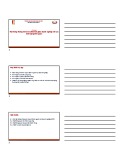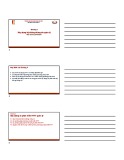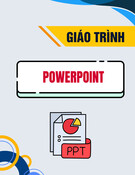
8/ 14/ 2013
1
ICT Tools for CORPORATE
GOVERNANCE
Chapter one: Corporate Governance
Concepts
1.1. what is Corporate Governance
A corporation is an organization created (incorporated)
by a group of shareholders who have ownership of the
corporation.
The elected board of directors appoint and oversee
management of the corporation .
Oxford English dictionary defines “governance "as the
act, manner , fact or function of governing sway control.
The word has Latin origins that suggest the notion of
“steering". it deals with the processes and systems by
which an organization or society operates.
Governance can be used with reference to all kind of
organizational structure e.g.
Ngo –not for profit organization
Municipal corporation /gram panchyat
Central/state government
Partnership firm

8/ 14/ 2013
2
It is a broad concept and has been defined and
understood differently by different groups and at
different points of time .
The Cadbury committee report defines it as “the system
by which companies are directed and controlled”.
•“ Corporat e governance deals wit h the ways in which
suppliers of finance to corporat ions assure them selves of
getting a ret urn on t heir investment ”.
•-The Journal of Finance, Shleifer and Vishny [1997].
CORPORATE
GOVERNANCE
CORPORATE
MANAGEMENT
External Focus Internal Focus
Governance assumes an
open system
Management assumes a
closed system
Strategy-orientated Task-orientated
Concerned with where the
company is going
Concerned with getting
the company there
s

8/ 14/ 2013
3
Supervisory board/committee/team
Audit committee
Internal audit
Statutory audit
Disclosure of information
Risk management framework
Internal control framework
Strengthen management oversight functions and
accountability.
Balance skills, experience and independence on the
board appropriate to the nature and extent of company
operations.
Establish a code to ensure integrity.
Safeguard the integrity of company reporting.
Risk management and internal control.
Disclosure of all relevant and material matters.
Recognition and preservation of needs of shareholders.
Board of directors
Managers
Workers
Shareholders or owners
Regulators
Customers
Suppliers
Community(people affected by the actions of the
organization.)
Directors
Every listed company should be headed by an effective
board which should lead and control the company.
There should be board balance of executive & non
executive directors such that no individual can dominate
the board decision making.
The board should be supplied with timely information to
enable it to discharge its duties.
There should be formal and transparent procedure for
the appointment of new directors to the board.
All directors should be required to submit themselves for
re-election at regular intervals and at least every three
years.

8/ 14/ 2013
4
Integrity of the management
Ability of the board
Adequacy of the process
Commitment level of individual board members
Quality of corporate reporting
Participation of stakeholders in the management
Demand for greater transparency and accountability
Written job descriptions detailing roles and responsibilities
of chairman and board members.
Core competencies for board members are defined and
those without skills or expertise not invited.
Development of performance criteria and annual
evaluations of the board.
Orientation for new members.
Ongoing training
Succession planning
Overseeing strategic development & planning
Management selection, supervision and upgrading.
Maintenance of good member relations.
Protecting and optimizing the organization’s assets.
Fulfilling legal requirements.
Example
Ac count a bilit y
Fundam ental Pillars of Corporat e
Governance
Corporat e
Gover na nc e
Transparency
Re sponsibilit y
Fa ir ne ss

8/ 14/ 2013
5
Accountability
Clarifying governance roles & responsibilities, and
supporting voluntary efforts to ensure the alignment of
managerial and shareholder interests and monitoring by
the board of directors capable of objectivity and sound
judgment.
Transparency
Requiring timely disclosure of adequate information
concerning corporate financial performance
Responsibility
Ensuring that corporations comply with relevant laws and
regulations that reflect the society’s values
Fairness
Ensuring the protection of shareholders’ rights and the
enforceability of contracts with service/resource providers
Invest ors are Willing to Pay M ore For a Company Wit h
Good Board Governance Pract ices
83 81 89
Companies are willing to pay 18 % to 28% more for better
governance.
Chapter 2: 7 Basic Quality Control
Tools – 7 QC Tools
•Check Sheet
•Ishikawa Diagram
•Pareto Chart
•Control Chart
•Histogram
•Scattergram
•St raticificat ion





![Tài liệu học tập Hệ thống thông tin quản lý [mới nhất, đầy đủ]](https://cdn.tailieu.vn/images/document/thumbnail/2025/20250716/vijiraiya/135x160/512_tai-lieu-hoc-tap-he-thong-thong-tin-quan-ly.jpg)






![Đề thi Excel: Tổng hợp [Năm] mới nhất, có đáp án, chuẩn nhất](https://cdn.tailieu.vn/images/document/thumbnail/2025/20251103/21139086@st.hcmuaf.edu.vn/135x160/61461762222060.jpg)


![Bài tập Tin học đại cương [kèm lời giải/ đáp án/ mới nhất]](https://cdn.tailieu.vn/images/document/thumbnail/2025/20251018/pobbniichan@gmail.com/135x160/16651760753844.jpg)
![Bài giảng Nhập môn Tin học và kỹ năng số [Mới nhất]](https://cdn.tailieu.vn/images/document/thumbnail/2025/20251003/thuhangvictory/135x160/33061759734261.jpg)
![Tài liệu ôn tập Lý thuyết và Thực hành môn Tin học [mới nhất/chuẩn nhất]](https://cdn.tailieu.vn/images/document/thumbnail/2025/20251001/kimphuong1001/135x160/49521759302088.jpg)


![Trắc nghiệm Tin học cơ sở: Tổng hợp bài tập và đáp án [mới nhất]](https://cdn.tailieu.vn/images/document/thumbnail/2025/20250919/kimphuong1001/135x160/59911758271235.jpg)


![Giáo trình Lý thuyết PowerPoint: Trung tâm Tin học MS [Chuẩn Nhất]](https://cdn.tailieu.vn/images/document/thumbnail/2025/20250911/hohoainhan_85/135x160/42601757648546.jpg)


